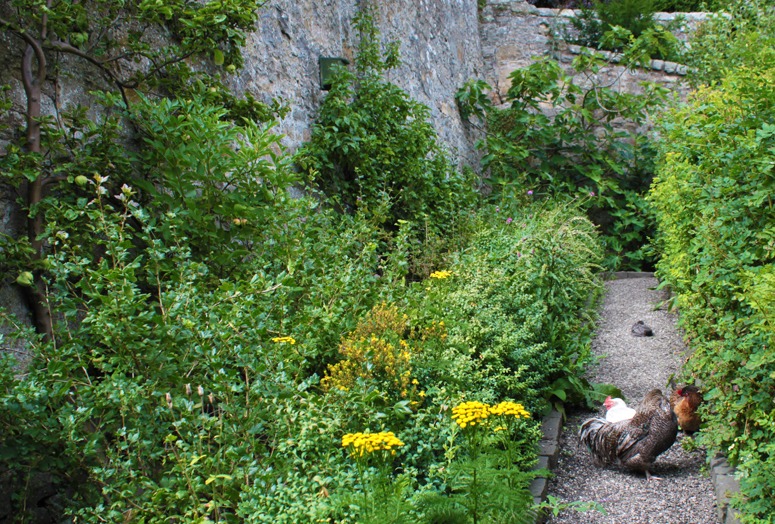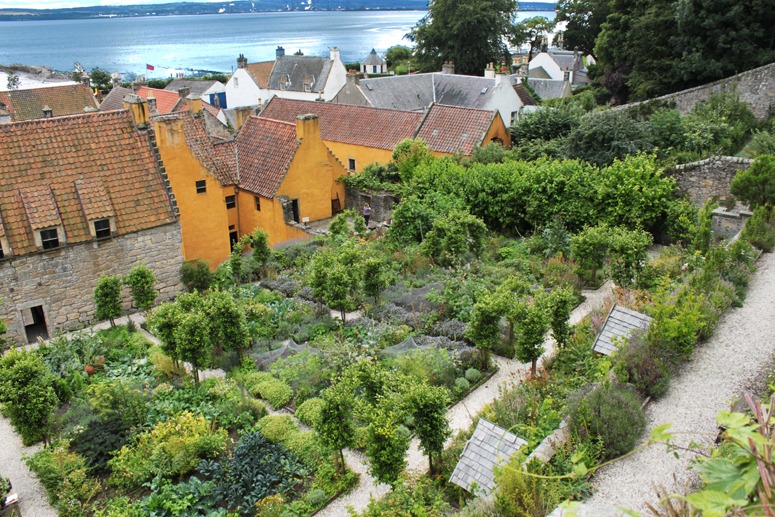‘Food gardening’ is a good American term for what the British tend to call ‘vegetable gardening’ – which is an inappropriate activity because it excludes fruit, fungii, honey, chickens, eggs, berries etc etc. But it would be better still if we could have an agreed name for what may have been principal activity in the world’s oldest garden and has certainly been carried on for a longer period than any other type of gardening: the combination of aesthetic and gastronimic objectives in enclosed and cultivated garden plots. Growing food was a major objective in Europe’s Medieval and Renaissance gardens – and may well (according to Craig Clunas) have been important in the pre-Qing classical gardens of China. In modern Europe and America food gardening is already showing signs of being the ‘next big thing’ in the design of private gardens and public parks. So we need a good name for this good activity. It is illustrated by photographs of Culross Palace Restored Medieval Garden.
I propose BEAUTIFUL FOOD GARDENING as a name for aesthetic-gastronomic horticulture but would welcome suggestions for alternatives.



Beautiful idea and garden.
I love the term you use to describe this type of gardening; it tells everything! On my side, I was playing with the words one day for I wanted to find a French word to describe my garden plot where ornamental plants and vegetables are growing pêle-mêle. Finally, I find plantager, a mix of plate-bande and potager. But it doesn’t describe the activity in itself, only the place.
Always nice to read your blog. Thanks you!
Thank you. Plantager is a good coinage and I hope it catches on – in France if not in Scotland.
While perhaps not beautiful Synthe is edible…
[ http://blog.archpaper.com/wordpress/archives/2074 ]
I like the SynthE project – but it would have been much better if they had used moulded acrylic shapes so that the space beneath (presumably surrounding service pipes which would support plants) could have been used as cloches to grow tomatoes etc. We have a lot of tomatoes at present (grown by my wife). Their flavour and texture is twice as good as any tomato I have ever had from a shop or restaurant (and even the so-called ‘organic’ tomatoes in the shops are vastly better than the ‘good value’ tomatoes). So we can look forward to a a future in which UK supermarkets offer:
Value Toms £1.50/kg
Organic Toms £4.00/kg
Tom’s Gourmet Toms £10.00/kg
Customers will be fighting for them. I just need to convert my green roof into a red roof (see below).
Pingback: Socrates, chives, tomatoes and biodiversity on my London roof garden | Garden Design And Landscape Architecture Blog – Gardenvisit.com
It is said that American farmers are ensuring a plentiful supply of rodents are flushed out at harvest time to ensure food for birds of prey, whose numbers have declined due to intensive agriculture and urban development.
[ http://www.unilever.com/sustainability/casestudies/Biodiversity/usa-protecting-wild-birds-on-tomato-farms.aspx ]
However, habitat and species conservation is only part of the biodiversity equation. Has your wife joined the heirloom fruits and vegetables movement?
[ http://findarticles.com/p/articles/mi_m1594/is_3_16/ai_n13776867/ ]
We have tried some heirloom fruits and vegetables – but if they yield smaller quantities of poorer quality produce then it is hard to keep on with them!
It would/will be a great thing if farmers took up a genuine committment to biodiversity – and if they could find advantages in this policy for themselves. I believe they exist.
The Carrot City Exhibition has some food for thought!
[ http://www.ryerson.ca/carrotcity/city.html ]
Perhaps these are grapes?
[ http://2.bp.blogspot.com/_P4Hsf74T70E/SvGPC69jPNI/AAAAAAAAAFM/L0YP_XGBlcE/s1600-h/untitled4.bmp ]
As for animals in urban areas…well I prefer the idea of Moose strolls through downtown Calgary.
[ http://seankheraj.wordpress.com/2010/05/14/moose-strolls-through-downtown-calgary/ ]
As a true Brit I could never give up the term ‘vegetable gardening’!